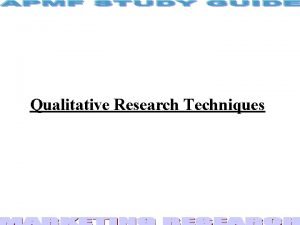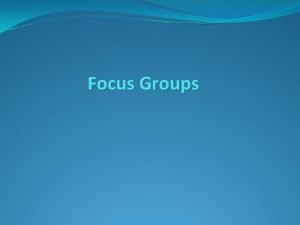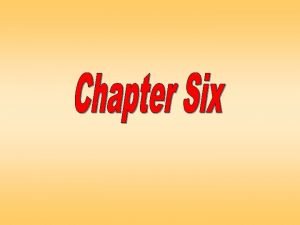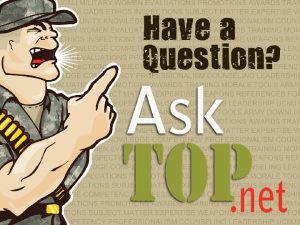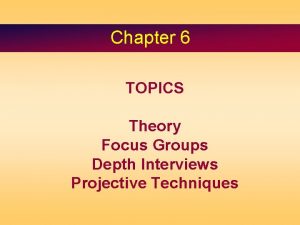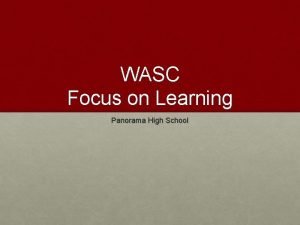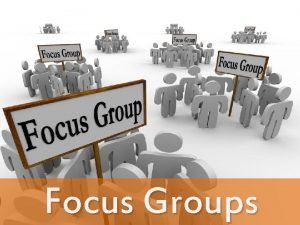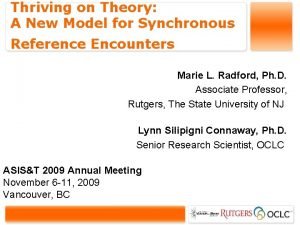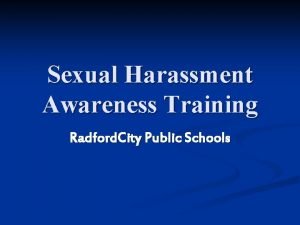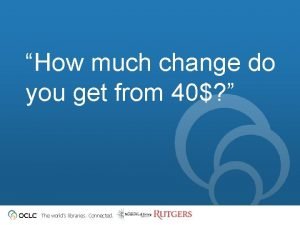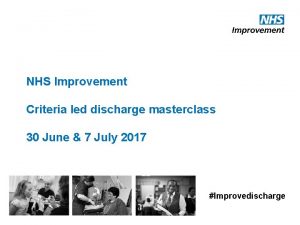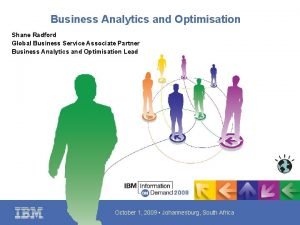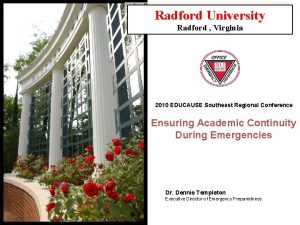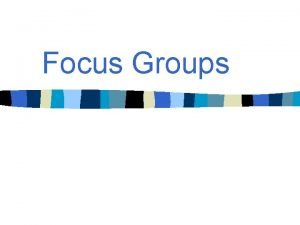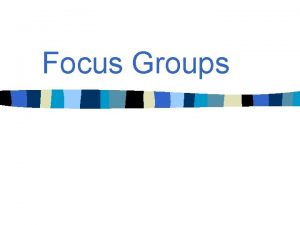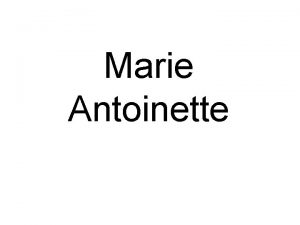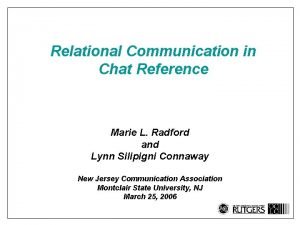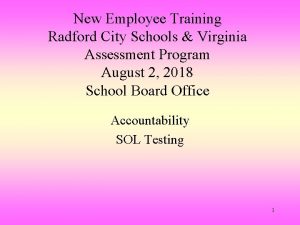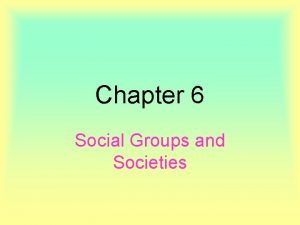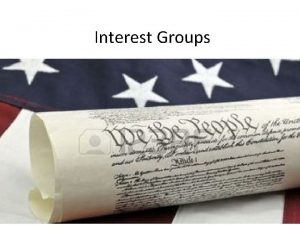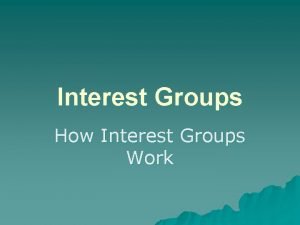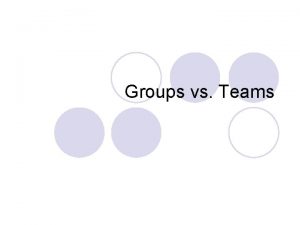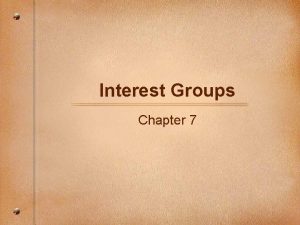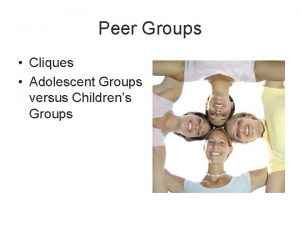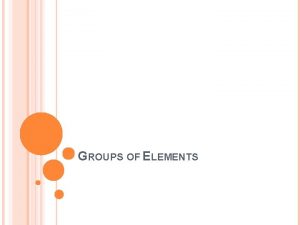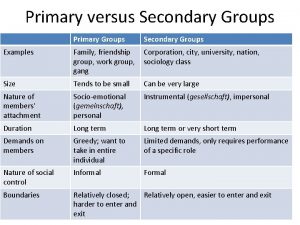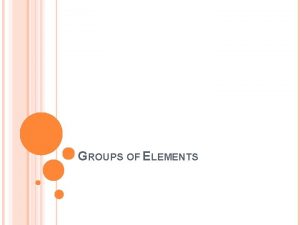Focus Groups as Assessment Tools Marie L Radford






















- Slides: 22

Focus Groups as Assessment Tools Marie L. Radford, Ph. D. , Associate Professor, Rutgers University mradford@scils. rutgers. edu LAMA/MAES Using Measurement Data for Library Planning & Assessment Committee “Got Data, Now What? Analyzing Focus Groups and Usability Study Results” ALA, Chicago, June 26, 2005 1

Participants How many have conducted FG & have data to analyze? l How many are planning FG? l How many are considering FG? l How many are skeptical of value of FG? l 2

AGENDA l l l Phase 1: Planning Phase 2: Conducting Focus Groups Phase 3: Analysis of Focus Group Data Phase 4: Reporting Results Using Focus Group Results in Strategic Planning 3

What is a Focus Group? “A focus group is an in-depth, face-to-face interview of a group of 8 to 12 people representing some target group and centered on a single topic. ” (Zweizig, Johnson, Robbins, & Besant, 1996) 4

Advantages of Using FG for Strategic Planning l l In-depth understanding of experiences & meanings. Better data – synergy created: l l l Comments stimulate others Unexpected insights More complete info. Elicit strong & common opinions Less inhibiting, less formal. Access needs of under-served or underrepresented groups. 5

Disadvantages Lots of planning & administration time! Skilled moderator required l Participants may be too quiet or too outspoken l Analysis, summarization & interpretation of responses may be difficult l Tape transcription - time consuming & costly l 6

Limitations Difficult to generalize l May not be representative l Analyzes perceptions, not facts l Subjective analysis (reliability requires more than 1 person) l Compensate by combining methods (surveys/observation) l 7

Phase I: Planning Crucial phase! l Communicate to stakeholders l Determine role of FG in overall assessment l What info. is needed? l Identify key issues Choose moderator & assistant (see handout) l l 8

More Planning l Identify target group(s) l l l Decide # of FG, 3 -4 per targeted population Identify pool Recruit volunteers l l Plan 8 -12 per group (over-recruit & remind) Offer reward (e. g. , free copycard, food) Seek representative members Form homogeneous groups: l Academic (e. g. , faculty, undergrads, grad. students) l Public (e. g. , adults, teenagers, non-users) 9

Yet More Planning… l Design FG guide, include: l l l Consider modified FG (see handout) Plan schedule (1. 5 -2. 5 hours each) l l l Introduction (purpose, ground rules) Ice breaker or warm-up set of questions Relevant major/probe questions (4 -5) Summary or closing When & Where Choose notes or tape recorder Choose method of data analysis 10

Phase II: Conducting Focus Groups l Bring/check supplies l l l l Flip chart, markers, masking tape, etc. If taping check equipment & have back-up Start on time, don’t waste time Begin by creating safe climate Obtain permission to use info. & if taping Help quiet people talk, limit talkative people Thank them! 11

Phase III: Analysis l l l Listen/transcribe tapes Review notes Ways to analyze data: l Use data to identify categories l l Repeated reading/listening Code data into pre-determined categories Use data as basis for summary statements “capture the essence” Modified FG already identifies priorities 12

Analysis, Cont. l l Compare across focus groups Compile & summarize Look for trends or problems to study Do not overgeneralize from results! 13

Phase IV: Reporting Results l Parts of Report l Bulleted executive summary l Statement of purpose l l List of issues Method (keep it brief!) l l l How data collected How analyzed Describe participants 14

Parts of Report, Cont. l l Summary of findings: l What said each issue l Consensus? l Comparison of groups Sample quotes (anonymous) l Few, well chosen, representative Interviewer’s impressions Recommendations: l Short term (low hanging fruit) l Long term 15

Library Strategic Planning Examples l Academic l Rutgers University Libraries l l l Major part of strategic planning initiative. Focus groups of students & faculty. 3 Campuses. 3 Moderators, 3 Assistants. Recruitment difficulties. Results extremely useful. 16

Public Library Example l Brooklyn Public Visual & Performing Arts Library l l Inform building project. Large urban library system. FG of community groups, artists, art educators. Report used in informing decision making, fund raising, & strategic planning. 17

Presenting to Administrators l For written or oral presentation l l Brevity is important Put your best foot forward! Highlight: l Positive results l Strategic directions l Major concerns Begin & end with quotation Bulleted executive summary may be all that is read (!) 18

Using Results for Strategic Planning l l Allow sufficient time to review results Use missions, goals for guidance Look at short & long term recommendations Prioritize recommendations 19

Using Results Cont. l l l Gain consensus Establish task forces or assign responsibilities Establish objectives, target dates Establish regular (6 mo. or annual) review process Create assessment plan 20

21

For More Information… l See list of books & articles. l Questions? ? l Thank you! 22
 Prolepsis
Prolepsis Cost focus and differentiation focus
Cost focus and differentiation focus Cost focus and differentiation focus
Cost focus and differentiation focus Actor focus vs object focus
Actor focus vs object focus Advantages of focus groups
Advantages of focus groups Advantage of focus groups
Advantage of focus groups Advantage of focus groups
Advantage of focus groups Strengths of focus groups
Strengths of focus groups Advantages and disadvantages of projective tests
Advantages and disadvantages of projective tests Focus group advantages
Focus group advantages Advantages of focus groups
Advantages of focus groups Wasc focus groups
Wasc focus groups Ground rules for focus groups
Ground rules for focus groups Different types of serial killers
Different types of serial killers Dr neill graff-radford
Dr neill graff-radford Radford
Radford Radford 2009
Radford 2009 Radford
Radford Radford
Radford Radford 2009
Radford 2009 Radford 2009
Radford 2009 Professor mark radford
Professor mark radford Radford data and analytics
Radford data and analytics





